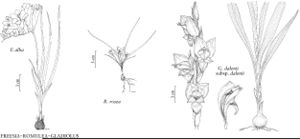Romulea rosea
Topogr. Verz. Pflanzensamml. Ecklon, 19. 1827.
Plants 3–12(–30) cm. Corm tunicate, 5–15 mm diam.; tunic hard, woody, splitting above and below into acuminate segments, those below bent backward. Stems usually branched below ground level; branches (peduncles) aerial, suberect, becoming falcate, ultimately erect. Leaves (2–)6–9, much exceeding stem; blade 10–30 cm × ca. 1.5 mm. Spathes green or flushed with purple; outer 12–25 mm, margin narrow, membranous; inner margin brown-streaked, broad, membranous. Tepals pink to purple, usually pale yellow in cup, outer pale abaxially, main veins dark green to purple, lanceolate, 13–22 × 3–4 mm; perianth tube 2–3.5 mm; filaments ca. 5 mm; anthers ca. 4 mm; style branching opposite upper 1/3 anthers; branches ca. 2 mm, shorter than anther apices. Capsules 10–15 mm. Seeds ca. 2 mm diam.
Phenology: Flowering mainly Mar–Apr.
Habitat: Abandoned dwellings, along paths, in meadows
Elevation: 0–50 m
Distribution
Introduced; Calif., South Africa.
Discussion
M. P. de Vos (1972) recognized five varieties of Romulea rosea; the plants naturalized in North America correspond to var. australis (Ewart) M. P. de Vos, which has become a common weed of lawns, pathways, and roadsides in Australia, where it is a pest. To date, weediness does not seem to be the case in the parts of California where the species occurs.
Selected References
None.
